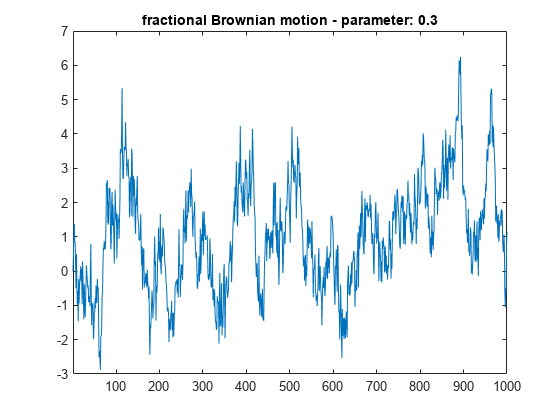wfbm
Fractional Brownian motion synthesis
Description
Examples
Input Arguments
Output Arguments
More About
Algorithms
Starting from the expression of the fBm process as a fractional
integral of the white noise process, the idea of the algorithm is to build a
biorthogonal wavelet depending on a given orthogonal one and adapted to the parameter
H.
Then the generated sample path is obtained by the reconstruction using the new wavelet starting from a wavelet decomposition at a given level designed as follows: details coefficients are independent random Gaussian realizations and approximation coefficients come from a fractional ARIMA process.
This method was first proposed by Meyer and Sellan and implementation issues were examined by Abry and Sellan [1].
Nevertheless, the samples generated following this original scheme exhibit too many high-frequency components. To circumvent this undesirable behavior Bardet et al. [2] propose downsampling the obtained sample by a factor of 10.
Two internal parameters delta = 10 (the downsampling factor) and a
threshold prec = 1E-4, to evaluate series by truncated sums, can be
modified by the user for extreme values of H.
A complete overview of long-range dependence process generators is available in Bardet et al [2].
References
[1] Abry, Patrice, and Fabrice Sellan. “The Wavelet-Based Synthesis for Fractional Brownian Motion Proposed by F. Sellan and Y. Meyer: Remarks and Fast Implementation.” Applied and Computational Harmonic Analysis 3, no. 4 (October 1996): 377–83. https://doi.org/10.1006/acha.1996.0030.
[2] Bardet, Jean-Marc, Gabriel Lang, Georges Oppenheim, Anne Philippe, Stilian Stoev, and Murad S. Taqqu. “Generators of Long-Range Dependent Processes: A Survey.” In Theory and Applications of Long-Range Dependence, edited by Paul Doukhan, Georges Oppenheim, and Murad S. Taqqu, 579–623. Boston: Birkhäuser, 2003.
Version History
Introduced before R2006a

